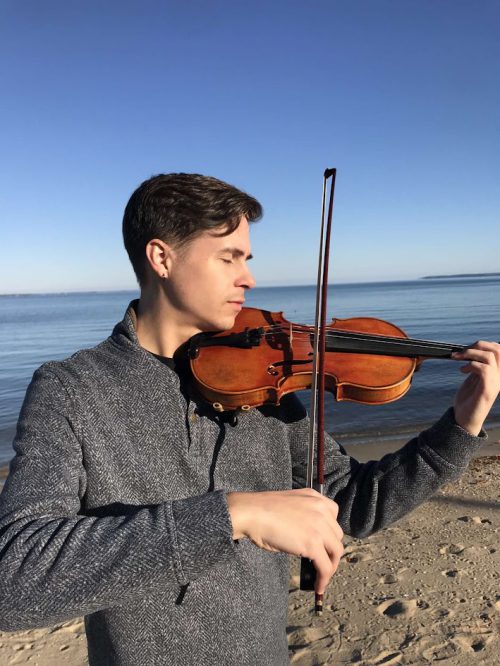Featured Image: Senior June Richardson plays their violin at the beach. June Richardson | Courtesy
With years of violin-playing under their belt, senior June Richardson began writing their own music in high school.
A whispery voice right behind your ear, ghostly and tingling. The sharp, acrid smell of smoke clogging in the air. Dark shadows floating in and out of the corner of your vision, somebody grabbing you sharply on the shoulder or a slightly metallic taste on your tongue. All are different types of sensations that are difficult to explain to others. But June Richardson, a violinist and composer at Virginia Wesleyan University, takes a different approach. Instead of using words, they focus on conveying these ideas and emotions through music composition.
“The purpose of the piece and the performance is…to evoke emotions. It’s just to tell a story and to make some kind of emotional impact,” Richardson said.
In addition to music composition, Richardson also studies mathematics, computer science and data science.
“It just blew me away,” Justin Stanley said. Stanley is the conductor of the Virginia Wesleyan University orchestra and has been teaching music for 13 years. He’s worked with Richardson for 3 years and smiled proudly as he talked about them. “Not only are they a genius in the math department (already being published in books before even graduating), but [they’re] taking the time to work on composing their own music in addition to playing the violin.”
Richardson started as a piano player, learning to tap the hard, smooth ivory keys at 3 years old. At 7, they switched to the violin to play a more portable instrument. Their family has been a big part of their musical background, by supporting and guiding their musical journey. Their love for music grew from there, leading them to become concertmaster, or lead violinist, in the Virginia Wesleyan University Orchestra.
In addition to playing here, they also play in a local orchestra, Symphonicity. The Symphonicity group provides them with a way to network with many other musicians in the area, and to learn and grow from them.
“The way they play the music is exactly how it’s meant to be,” Claire Holman said, expressing her admiration of Richardson’s skill. Holman is a fellow violinist and classmate of Richardson. Holman enjoys listening to Richardson’s music and performance; she explained that she’s even gone to musical performance opportunities just to hear Richardson play.
But playing music is no longer Richardson’s main focus.
“Music is a big part of my life and violin is only a portion of that,” they said.
That was okay with them, they explained with a cheerful shrug, because they had found a new focus for their musical studies.
“It was 10th grade in high school when I realized that my passion for writing music had surpassed my passion for performing on the violin. And that was simply because, I know it sounds weird to say, but my technical abilities on the violin had kind of plateaued around that time,” Richardson said.
While the music Richardson first composed might have been, as they said, “very boring” and sounded like a typical classical piece, their skills have evolved since then through practice, a feat that impresses many teachers and classmates alike.
“Personally, I find composing to be one of the most difficult projects a musician could do,” Stanley said. “You have to create something that is uniquely your own. Not a copy of something someone else has already done. You have to find your own voice.”
Richardson works with this idea as well, using music composition as a creative outlet to stand out from other composers. Currently, they’re working on their longest and most personal piece yet: “Images.”
“[Images] is the most emotionally involved piece I’ve ever written in my life,” Richardson said with a thoughtful nod. They explained the basis for it: a piece about the five senses and how it feels to be deceived by them by hallucinations, as interpreted by Richardson.
The piece is divided into 5 movements, entitled “Apparition” for sight, “Provocation” for sound, “Stench” for smell, “Clasp” for touch, and “Savor” for taste. Based on Debussy’s work of the same name, Richardson’s “Images” is an impressionistic piece aimed at conveying how each of these hallucinations might feel to the audience, based on Richardson’s own experiences.
“Apparition” takes the dark shapes dancing at the edges of your vision and becomes a slow, eerie movement filled with creeping, haunting sounds. A bright voice tingling in your ear transforms into an explosion of sharp, bright notes in “Provocation.” “Stench,” Richardson’s personal favorite, becomes a short, slow, cascade of notes that might remind you of familiar, unpleasant scents hanging in the air, while “Clasp” conveys the idea of unfamiliar, unwelcome touches through a flurry of unexpected, frenetic notes. Finally, “Savor” ends the piece with a sweet, “cute” movement of pleasant notes that can remind you to savor the moment.
Richardson intends to make “people feel ‘wow’ while listening to it.”
“It’s powerful,” Richardson said.
While responses might be positive or negative, Richardson has filled the piece with enough emotion to leave a lasting impression.
While “Images” is not finished yet, it already stands at 61 pages. Richardson explained that the piece would probably end around 65 pages, with each movement standing as a musically distinct, independently performable piece. Richardson plans to perform the piece in its entirety for their graduation recital, as well as hosting a composer’s talk on campus to perform the piece and discuss their compositional style.
“I think it will be a monumental way to leave a lasting mark on the music department and the school, even more than they already have,” Stanley said with an excited smile.
“I do have some other plans for the future,” Richardson said, hinting at more symphonies and compositions to come.
“I’m really intrigued to see what they’re going to do,” Holman said. For now, the world can only wait for the curtains to rise and Richardson’s compositions to fill the stage.
Gabrielle Barnett
gabarnett@vwu.edu



